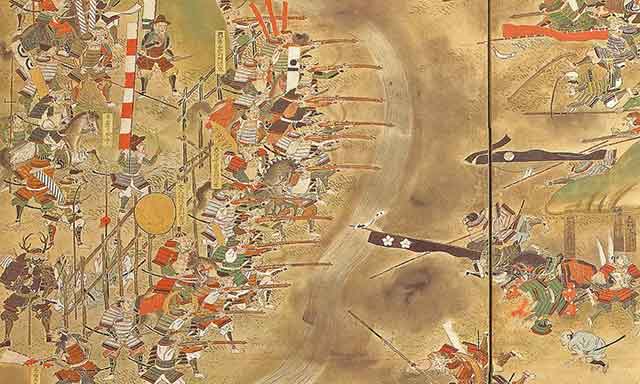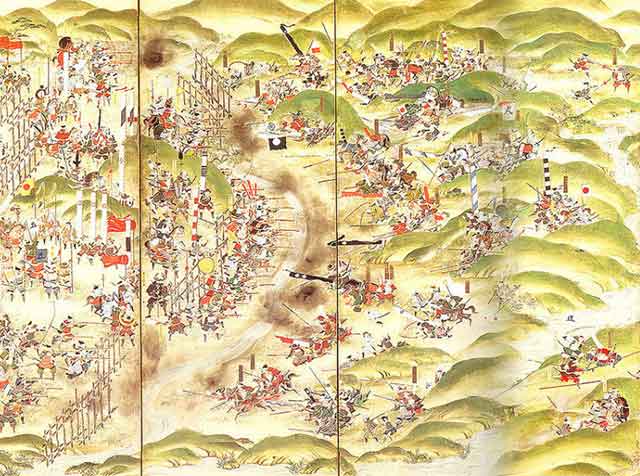
In the early 16th century, the most formidable samurai cavalry army was the Takeda. At that time, it was a mighty military force that always won victory on the battlefield. At the head was Takeda Shingen, who had two sons. It was the sons who continued his work after the death of their father. The main task was to capture Mikawa, which belonged to Tokugawa Ieyasu. However, everything did not go according to plan. The power and strength of the Takeda army, which everyone feared, changed dramatically in the second half of the 16th century.
Brave Warrior Tori
In early May 1575, an army of 15,000 soldiers led by Takeda Katsuyori entered Tokugawa territory. The first thing the warriors did was to surround Yoshida Castle. However, the castle became the first obstacle to the conquest, as the soldiers could not destroy it. Then they began to move north, with the goal of encircling Nagashino Castle. And at this stage, the Takeda army was also expected to be defeated. This moment went down in history as the Battle of Nagashino.
Torii Suniemon managed to escape from the castle. This is a brave ashigaru who was able to break out of the castle and call for reinforcements from the Tokugawa. His story of escaping from the castle is unique. The brave warrior left the castle, swam across the fast river, bypassing the nets that were placed by the enemy, and then ran 35 km to Okazaki. Requesting reinforcements from the allies, Tori returned to Nagashino. However, while trying to get back to the castle, he was captured by the enemy.
Tory was tied to a wooden cross and put on display across the river from the castle. The enemy ordered Tori to tell the men that the castle had been surrendered and there would be no reinforcements. However, the brave warrior did not follow the order. From a height, he examined his samurai, who were located on the observation towers, and shouted loudly: "People of Nagashino castles do not give up, reinforcements are on their way, wait a bit." For this, the Takeda soldier stuck a spear in Tori's stomach.
One of the Takeda detachments was so surprised by the courage and devotion of Torii that an order was given to design a battle flag with the image of the crucified. The posthumously glorious warrior was promoted to the rank of full hereditary samurai. His efforts led to the most famous samurai battle, the Battle of Nagashino.
A week later, reinforcements arrived at the site of the main battle. These were the Tokugawa forces and allied Oda. The total number of soldiers numbered 38 thousand.
Combat equipment of the samurai Oda
The combat equipment of the Oda samurai also deserves special attention. They carried not only a tool, armor, but also a long thin wooden log. In this case, from these wooden logs, the Oda warriors managed to build almost 2 km of a wooden palisade on the western side at the foot of the hilly area.
The Battle of Nagashino between the armies took place on May 21, 1575. Takeda's army was the first to attack. In front were the horsemen, and behind them were the infantry. However, their movement was not as fast as it should have been. At first the army was slowed down by the soft, muddy rice paddies, then much time was spent crossing the Rengo River. After that, the Takeda army had to go through several more rice fields before reaching the log fence that was built by the Oda samurai.

Behind the fence, 3,000 Oda soldiers were waiting for them. Each soldier was armed with a matchlock gun. It is worth noting that a gun of this type was brought to Japan only 30 years ago before the start of a big battle. The arrows of Oda very quickly killed the opponent with a powerful shot.
After the first line of attack was destroyed, Katsuyori quickly sent out a second wave of samurai. However, just a few seconds later they were also killed by heavy rifle fire. The commander was greatly shocked, but did not give up his positions. He tried again to line up the lines of the troops, but they were also completely slanted.
Thus, in this great battle, the power of firearms won. In this battle, the correct tactics chosen by General Nobunaga also played. He became a true innovator. First of all, he was well aware of the shortcomings of throwing weapons and, taking advantage of this, managed to properly line up his shooters. To do this, he placed them in small groups of 3 around the barricades. After the first shot, the second line took aim and fired. By this time, the first line had time to reload and was ready to continue the battle. Thus, a volley of fire constantly occurred.
The second blow was delivered by ashigaru foot soldiers. As soon as the Takeda samurai approached the palisade, he was immediately stopped by the ashigaru foot soldiers. They had long spears.
In this big battle, Takeda continued to actively attack, and Oda continued to shoot and fight. The battle lasted over 8 hours. The result of a massive battle: 10 thousand dead Takeda samurai and 6 thousand soldiers of the allied forces. The Takeda clan, which was very formidable, was destroyed. And 7 years after this battle, an inglorious end awaited him.
See also
-
The Siege of Hara Castle

The Shimabara Rebellion of 1637–1638, which culminated in the siege of Hara Castle, was the last major uprising of the Edo period and had serious political consequences.
-
Battle of Tennoji

The confrontation between Tokugawa Ieyasu and Toyotomi Hideyori during the “Osaka Winter Campaign” ended with the signing of a peace treaty. On January 22, 1615, the day after the treaty was signed, Ieyasu pretended to disband his army. In reality, this meant that the Shimazu forces withdrew to the nearest port. On the same day, almost the entire Tokugawa army began filling in the outer moat.
-
Siege of Shuri Castle

The Ryukyu Kingdom was established in 1429 on Okinawa, the largest island of the Ryukyu (Nansei) archipelago, as a result of the military unification of three rival kingdoms. In the following years, the state's control spread to all the islands of the archipelago.
-
The Siege of Fushimi Castle

Fushimi can perhaps be considered one of the most “unfortunate” castles of the Sengoku Jidai period. The original castle was built by Toyotomi Hideyoshi in the southeast of Kyoto in 1594 as his residence in the imperial city.
-
The Siege of Otsu Castle

The siege of Otsu Castle was part of the Sekigahara campaign, during which the so-called Eastern Coalition, led by Tokugawa Ieyasu, fought against the Western Coalition, led by Ishida Mitsunari. Otsu Castle was built in 1586 by order of Toyotomi Hideyoshi near the capital Kyoto, on the site of the dismantled Sakamoto Castle. It belonged to the type of “water castles” — mizujō — as one side of it faced Japan's largest lake, Lake Biwa, and it was surrounded by a system of moats filled with lake water, which made the fortress resemble an island.
-
The Siege of Shiroishi Castle

The siege of Shiroishi Castle was part of the Sekigahara campaign and took place several months before the decisive battle of Sekigahara. The daimyo of Aizu Province, Uesugi Kagekatsu, posed a serious threat to Tokugawa Ieyasu's plans to defeat the Western Coalition, and Ieyasu decided to curb his actions with the help of his northern vassals. To this end, he ordered Date Masamune to invade the province of Aizu and capture Shiroishi Castle.
-
The Second Siege of Jinju Castle

During the two Korean campaigns of the 16th century, the Japanese repeatedly had to capture enemy fortresses and defend occupied or constructed fortifications from the combined Korean and Chinese forces. Among all the operations of that time, the second siege of Jinju Castle is considered the most interesting from the point of view of siege warfare.
-
The Siege of Takamatsu Castle

The siege of Takamatsu Castle in Bitchu Province is considered the first mizuzeme, or “water siege,” in Japanese history. Until then, such an original tactic had never been used.

